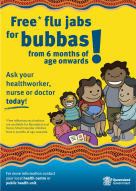The immunisations range from birth through to adulthood. All vaccines listed in the NIP Schedule are free. Eligibility for free vaccines under the NIP is linked to eligibility for Medicare benefits. Influenza vaccination every year is recommended for everyone. Below the table is a brief explanation of the types of vaccinations used.
The program starts for an Australian when they are born. Vaccinations are given at birth, then again when the baby is months, months, months, months and months. It’s heart wrenching to read about families that have lost their children to diseases like measles, whooping cough or chicken pox.
Immunisation is a simple, safe and effective way of. While Australia ’s immunisation rates for five year olds are close to the government’s target of per cent, children aged between one and two have a lower immunisation rate, with some areas as low as per cent. Meningococcal B program.
All Aboriginal children ˂years of age are recommended and funded to receive three doses of Bexsero at weeks, months and months of age. An additional dose for Aboriginal children years of age with certain at risk conditions may be required. Catch-up Calculator. Information on how to access immunisation records from the national immunisation registers and the school immunisation program Pregnancy and immunisation Information on the importance of getting the flu vaccine during pregnancy, any time of the year.
Children should receive a dose of MenACWY vaccine at months of age, even if they have received doses earlier in infancy. The recommended schedule for adolescents aged 9–years is doses, with a 6–12-month interval between doses. The NIP Schedule is a series of immunisations given at specific times throughout your life.

Contact your state or territory health service for school grades eligible for vaccination. Why vaccination is safe and important 6-in-vaccine. The vaccine history timeline shows when vaccines were introduced and major changes to the immunisation schedule over time.
Diphtheria, tetanus, whooping cough, hepatitis B, polio, Haemophilus influenzae type b (injection) Pneumococcal (injection) Rotavirus (drops in mouth) Aboriginal children. AusVaxSafety has captured information from over a million people in Australia. The data shows that the rates of adverse effects after vaccination extremely low. Globally, the Australian NIP continues to be one of the most comprehensive, fully funded immunisation programs in the world. Changes to the childhood immunisation schedule aim to improve protection against meningococcal, pneumococcal and Haemophilus influenzae type b diseases.
Please speak to your immunisation provider to ensure your child receives all the vaccines for which they are eligible. The Australian Government funds teenage immunisations on the NIP schedule. You don’t normally pay for an NIP immunisation if your child gets this service at school. To be fully protected against some diseases, your child might need to be immunised 2-times at different ages. The Victorian immunisation schedule lists the vaccines that are given free of charge and at what age.
New vaccines continue to be developed and the schedule might be updated in the future. If vaccine doses are delayed or misse the calculator can provide a catch-up schedule. You can use this service if you’re settling in Australia or if you’re already living here permanently. We can only accept information directly from a recognised vaccination provider in Australia.
Children need a flu shot to protect them against influenza viruses. Every year in Australia , hundreds of children get so unwell from influenza they need to be treated in hospital. Most of them are babies and children under five years. ID (available from the ACARA Australian Schools List). To change the schedule , you can select another schedule from the drop down.
The Vaccine Schedule is an ECDC tool and interactive platform of vaccination schedules for individual European countries and specific age groups. Added routine childhood immunisation schedule for infants born.
No comments:
Post a Comment
Note: only a member of this blog may post a comment.